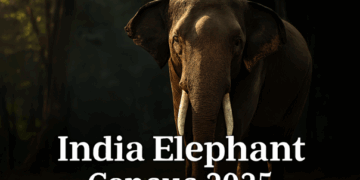The India Elephant Census 2025 has revealed a significant decline in the country’s wild elephant population, marking a turning point in wildlife conservation efforts. Conducted jointly by the Environment Ministry, Project Elephant, and the Wildlife Institute of India, this was the nation’s first-ever DNA-based elephant count.
Overview
The census estimates India’s wild elephant population at 22,446, down from 27,312 in 2017—an 18% drop. The All-India Synchronous Elephant Estimation (SAIEE) 2025 places the population between 18,255 and 26,645, with 22,446 as the average.
Methodology
Unlike previous visual counts, the 2025 census used DNA fingerprinting. Scientists collected over 21,000 dung samples across elephant habitats and identified individual elephants using genetic markers. This method is considered more accurate and less invasive.
State-Wise Elephant Population
| State | Elephant Count |
|---|---|
| Karnataka | 6,013 |
| Assam | 4,159 |
| Tamil Nadu | 3,136 |
| Kerala | 2,785 |
| Uttarakhand | 1,792 |
Regional Distribution
The Western Ghats continue to be the largest stronghold with 11,934 elephants. Northeast India, including the Brahmaputra floodplains, hosts over 6,500 elephants. Central and eastern regions showed fragmentation of herds due to habitat disruption.
Reasons for Decline
- Rapid urbanization and infrastructure development
- Encroachment into forest areas
- Human-elephant conflict in shared landscapes
- Loss of migratory corridors and fragmentation of habitats
Conservation Implications
The census provides a new scientific baseline for future conservation planning. Authorities are expected to revise habitat protection strategies, strengthen corridor connectivity, and enhance community engagement in elephant landscapes.
Technological Innovations
Use of satellite mapping, genetic analysis, and AI-based data validation tools made this census the most advanced wildlife survey ever conducted in India. The total field effort covered over 6.7 lakh km of forest trails and 3.1 lakh dung plots.
Policy Recommendations
- Expand protected areas and buffer zones
- Implement early warning systems for human-elephant conflict
- Introduce compensation schemes for crop damage
- Promote eco-tourism and community-led conservation
Community Engagement and Local Stewardship
One of the most overlooked aspects of elephant conservation is the role of local communities. Forest-dwelling populations and agrarian villages located near elephant corridors are often the first to experience human-elephant conflict. The 2025 census highlights the need for inclusive conservation models that empower these communities as stewards rather than adversaries.
Initiatives such as participatory monitoring, crop insurance schemes, and eco-tourism cooperatives have shown promise in regions like Wayanad and Kaziranga. By integrating local knowledge systems with scientific data, authorities can build trust and reduce retaliatory harm to elephants. The census recommends scaling such models across all elephant landscapes.
Long-Term Strategy and Policy Integration
Beyond immediate conservation measures, the census calls for a long-term strategy that aligns with India’s broader environmental goals. This includes integrating elephant conservation into climate resilience planning, forest restoration programs, and infrastructure development policies. The Ministry of Environment is expected to release a 10-year action plan based on the census findings.
Key components of this strategy will include corridor mapping, land acquisition for migratory routes, and the use of AI-powered conflict prediction tools. The goal is to create a landscape-level approach that balances ecological integrity with human development.
Global Significance
India’s elephant population represents over 60% of the global wild Asian elephant count. The 2025 census, with its pioneering use of DNA technology, sets a benchmark for other countries in Asia and Africa. Conservationists worldwide are watching India’s model closely, especially its integration of genetic data, satellite mapping, and community engagement.
As the country moves forward, the Elephant Census 2025 will serve not just as a data point—but as a blueprint for ethical, inclusive, and technologically advanced wildlife conservation.
Conclusion
The India Elephant Census 2025 is not just a statistical exercise—it’s a wake-up call. With over half of the world’s Asian elephants residing in India, the country must act decisively to reverse the decline and secure the future of its iconic species.



















